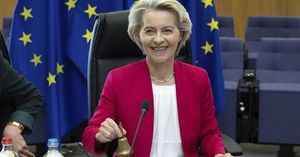The recent decision by the Federal Reserve to cut interest rates for the second time this year has stirred discussions about the direction of the U.S. economy, particularly as Donald Trump returns to the political spotlight. The Federal Open Market Committee (FOMC) voted unanimously on November 7, 2024, to lower the benchmark interest rate by a quarter percentage point, bringing it down to the range of 4.5% to 4.75%. This follows a previous half-point cut implemented just weeks prior, aimed at stimulating economic growth and combatting inflationary concerns.
Federal Reserve Chair Jerome Powell characterized the current economic climate as solid, noting resilient consumer spending and job market conditions, though inflation remains slightly above the Fed's target of 2%. Powell emphasized the importance of calibrated policy adjustments moving forward, stating, “We continue to be confident with our policy stance to maintain economic strength and guide inflation toward our goal.”
Despite the cuts, many consumers may not immediately feel the effects. Dante DeAntonio, labor economist at Moody’s Analytics, pointed out, “While we anticipate rates across many spectrums to eventually decrease, the impacts won’t be felt overnight.” Rates for credit cards, auto loans, and mortgages may see gradual decreases as the Fed's recent actions filter through the economy, but changes are expected to be measured rather than drastic.
Last week, the Bureau of Labor Statistics reported disappointing job growth, with only 12,000 jobs added, but Powell suggested this was largely due to external factors like strikes and hurricanes affecting industries. Nevertheless, he acknowledged the potential impact of Trump’s economic policies, hinting at possible changes to the Fed's approach if Trump's administration pursues its proposed economic agenda aggressively. Experts forewarn about inflationary pressures stemming from suggested tariffs on imports and other fiscal changes if Trump adheres to pledges made during his campaign.
Mark Zandi, chief economist at Moody's, echoed concerns about the coming administration. “If Trump implements broad tariffs and large-scale changes to immigration policy, we might see inflationary risks rise, complicate the Fed’s path, and possibly lead to future interest rate hikes,” Zandi stated. These sentiments highlight the complex interplay between presidential policies and central banking decisions.
The Fed's decision to lower rates, even amid the uncertainty surrounding Trump’s return, showcases its commitment to fostering economic stability. Prior to the latest cuts, the Fed had engaged in significant rate hikes, having increased rates 11 times from March 2022 to July 2023 to counteract surging inflation. Now, with inflation reportedly easing, the Fed is evaluating how much room it has to adjust without triggering economic over-expansion.
What about the consumer's immediate financial concerns? While interest rates decreasing might appear beneficial on the surface, mortgage rates have not followed the same downward trend. Mortgage rates have stubbornly remained high, with averages hovering around 6.79% as of November 7, 2024, following initial reductions. Experts indicate various factors outside of the Fed's control affect mortgage rates, primarily influenced by treasury yields and investor sentiment.
Shawn DuBravac of the Avrio Institute noted, “Mortgage rates are particularly sensitive to the yields of longer-term bonds, such as the 10-year Treasury note, which are shaped by both Fed policies and broader economic trends,” underscoring the multifaceted influences on mortgage pricing.
For everyday consumers and those carrying debt, the Fed's actions may not signify immediate relief but instead reflect longer-term strategic adjustments. High-interest rates for credit cards and loans will likely persist. For example, even after the cuts, the average credit card interest rate had only shifted slightly from 20.78% to 20.39%.
Looking forward, the Fed will convene again in December, and any new policy direction will hinge on the incoming administration's economic strategies alongside new economic data, including inflation rates and labor market performance.
Meanwhile, opinions on the effectiveness of the Fed's rate cuts remain mixed, and many economists point to the need for caution. With Trump's policies still uncertain, the Fed will face great pressure to navigate smoothly through these changes and maintain its reputation for independence and sound economic management.
Investors currently appear to be bracing for possible increases in inflation due to Trump’s campaign commitments. His promises of tariffs on imports could lead to increased costs of goods, which the Fed must address proactively to avoid stalling economic momentum. Powell has reiterated the Fed's commitment to acting based on data trends and not political pressures, asserting, “We don’t guess, we don’t speculate, we don’t assume.”
Overall, the Federal Reserve’s decision to cut interest rates amid the political shifts offers both opportunities and challenges as the country prepares for continued economic transitions. The coming months will reveal whether these cuts will bolster investment and consumer spending or if rising inflation levels might force the Fed to reevaluate its path.
Despite the potential for short-term disruptions, the central bank's aim remains clear: supporting sustainable economic growth and keeping inflation anchored—all underpinned by its independence from political influence. How effectively they can maintain this balance will be pivotal as America navigates this new chapter.



